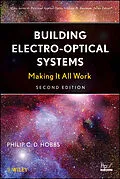Praise for the First Edition
"Now a new laboratory bible for optics researchers has joined
the list: it is Phil Hobbs's Building Electro-Optical Systems:
Making It All Work."
--Tony Siegman, Optics & Photonics News
Building a modern electro-optical instrument may be the most
interdisciplinary job in all of engineering. Be it a DVD player or
a laboratory one-off, it involves physics, electrical engineering,
optical engineering, and computer science interacting in complex
ways. This book will help all kinds of technical people sort
through the complexity and build electro-optical systems that just
work, with maximum insight and minimum trial and error.
Written in an engaging and conversational style, this Second
Edition has been updated and expanded over the previous edition
to reflect technical advances and a great many conversations with
working designers. Key features of this new edition include:
* Expanded coverage of detectors, lasers, photon budgets, signal
processing scheme planning, and front ends
* Coverage of everything from basic theory and measurement
principles to design debugging and integration of optical and
electronic systems
* Supplementary material is available on an ftp site, including
an additional chapter on thermal Control and Chapter problems
highly relevant to real-world design
* Extensive coverage of high performance optical detection and
laser noise cancellation
Each chapter is full of useful lore from the author's years of
experience building advanced instruments. For more background, an
appendix lists 100 good books in all relevant areas, introductory
as well as advanced. Building Electro-Optical Systems: Making It
All Work, Second Edition is essential reading for researchers,
students, and professionals who have systems to build.
Autorentext
Philip C. D. Hobbs, PhD, is Principal of ElectroOptical Innovations, a consultancy in Briarcliff Manor, New York.
Zusammenfassung
Praise for the First Edition
"Now a new laboratory bible for optics researchers has joined the list: it is Phil Hobbs's Building Electro-Optical Systems: Making It All Work."
Tony Siegman, Optics & Photonics News
Building a modern electro-optical instrument may be the most interdisciplinary job in all of engineering. Be it a DVD player or a laboratory one-off, it involves physics, electrical engineering, optical engineering, and computer science interacting in complex ways. This book will help all kinds of technical people sort through the complexity and build electro-optical systems that just work, with maximum insight and minimum trial and error.
Written in an engaging and conversational style, this Second Edition has been updated and expanded over the previous edition to reflect technical advances and a great many conversations with working designers. Key features of this new edition include:
- Expanded coverage of detectors, lasers, photon budgets, signal processing scheme planning, and front ends
- Coverage of everything from basic theory and measurement principles to design debugging and integration of optical and electronic systems
- Supplementary material is available on an ftp site, including an additional chapter on thermal Control and Chapter problems highly relevant to real-world design
- Extensive coverage of high performance optical detection and laser noise cancellation
Each chapter is full of useful lore from the author's years of experience building advanced instruments. For more background, an appendix lists 100 good books in all relevant areas, introductory as well as advanced. Building Electro-Optical Systems: Making It All Work, Second Edition is essential reading for researchers, students, and professionals who have systems to build.
Inhalt
Preface.
Acknowledgments.
1. Basic Optical Calculations.
1.1 Introduction.
1.2 Wave Propagation.
1.3 Calculating Wave Propagation in Real Life.
1.4 Detection.
1.5 Coherent Detection.
1.6 Interferometers.
1.7 Photon Budgets and Operating Specifications.
1.8 Signal Processing Strategy.
2. Sources and Illuminators.
2.1 Introduction.
2.2 The Spectrum.
2.3 Radiometry.
2.4 Continuum Sources.
2.5 Interlude: Coherence.
2.6 More Sources.
2.7 Incoherent Line Sources.
2.8 Using Low Coherence Sources: Condensers.
2.9 Lasers.
2.10 Gas Lasers.
2.11 Solid State Lasers.
2.12 Diode Lasers.
2.13 Laser Noise.
2.14 Diode Laser Coherence Control.
3. Optical Detection.
3.1 Introduction.
3.2 Photodetection in Semiconductors.
3.3 Signal to Noise Ratios.
3.4 Detector Figures of Merit.
3.5 Quantum Detectors.
3.6 Quantum Detectors with Gain.
3.7 Thermal Detectors.
3.8 Image Intensifiers.
3.9 Silicon Array Sensors.
3.10 How Do I Know Which Noise Source Dominates?
3.11 Hacks.
4. Lenses, Prisms, and Mirrors.
4.1 Introduction.
4.2 Optical Materials.
4.3 Light Transmission.
4.4 Surface Quality.
4.5 Windows.
4.6 Pathologies of Optical Elements.
4.7 Fringes.
4.8 Mirrors.
4.9 Glass Prisms.
4.10 Prism Pathologies.
4.11 Lenses.
4.12 Complex Lenses.
4.13 Other Lens-like Devices.
5. Coatings, Filters, and Surface Finishes.
5.1 Introduction.
5.2 Metal Mirrors.
5.3 Transmissive Optical Coatings.
5.4 Simple Coating Theory.
5.5 Absorptive Filters.
5.6 Beam Dumps and Baffles.
5.7 White Surfaces and Diffusers.
6. Polarization.
6.1 Introduction.
6.2 Polarization of Light.
6.3 Interaction of Polarization with Materials.
6.4 Absorption Polarizers.
6.5 Brewster Polarizers.
6.6 Birefringent Polarizers.
6.7 Double-Refraction Polarizers.
6.8 TIR Polarizers.
6.9 Retarders.
6.10 Polarization Control.
7. Exotic Optical Components.
7.1 Introduction.
7.2 Gratings.
7.3 Grating Pathologies.
7.4 Types of Gratings.
7.5 Resolution of Grating Instruments.
7.6 Fine Points of Gratings.
7.7 Holographic Optical Elements.
7.8 Retroreflective Materials.
7.9 Scanners.
7.10 Modulators.
8. Fiber Optics.
8.1 Introduction.
8.2 Fiber Characteristics.
8.3 Fiber Theory.
8.4 Fiber Types.
8.5 Other Fiber Properties.
8.6 Working with Fibers.
8.7 Fiber Devices.
8.8 Diode Lasers and Fiber Optics.
8.9 Fiber Optic Sensors.
8.10 Intensity Sensors.
8.11 Spectrally Encoded Sensors.
8.12 Polarimetric Sensors.
8.13 Fiber Interferometers.
8.14 Two-Beam Fiber Interferometers.
8.15 Multiple-Beam Fiber Interferometers.
8.16 Phase and Polarization Stabilization.
8.17 Multiplexing and Smart Structures.
8.18 Fiber Sensor Hype.
9. Optical Systems.
9.1 Introduction.
9.2 What, Exactly, Does a Lens Do?
9.3 Diffraction.
9.4 Aberrations.
9.5 Representing Aberrations.
9.6 Optical Design Advice.
9.7 Practical Applications.
<...